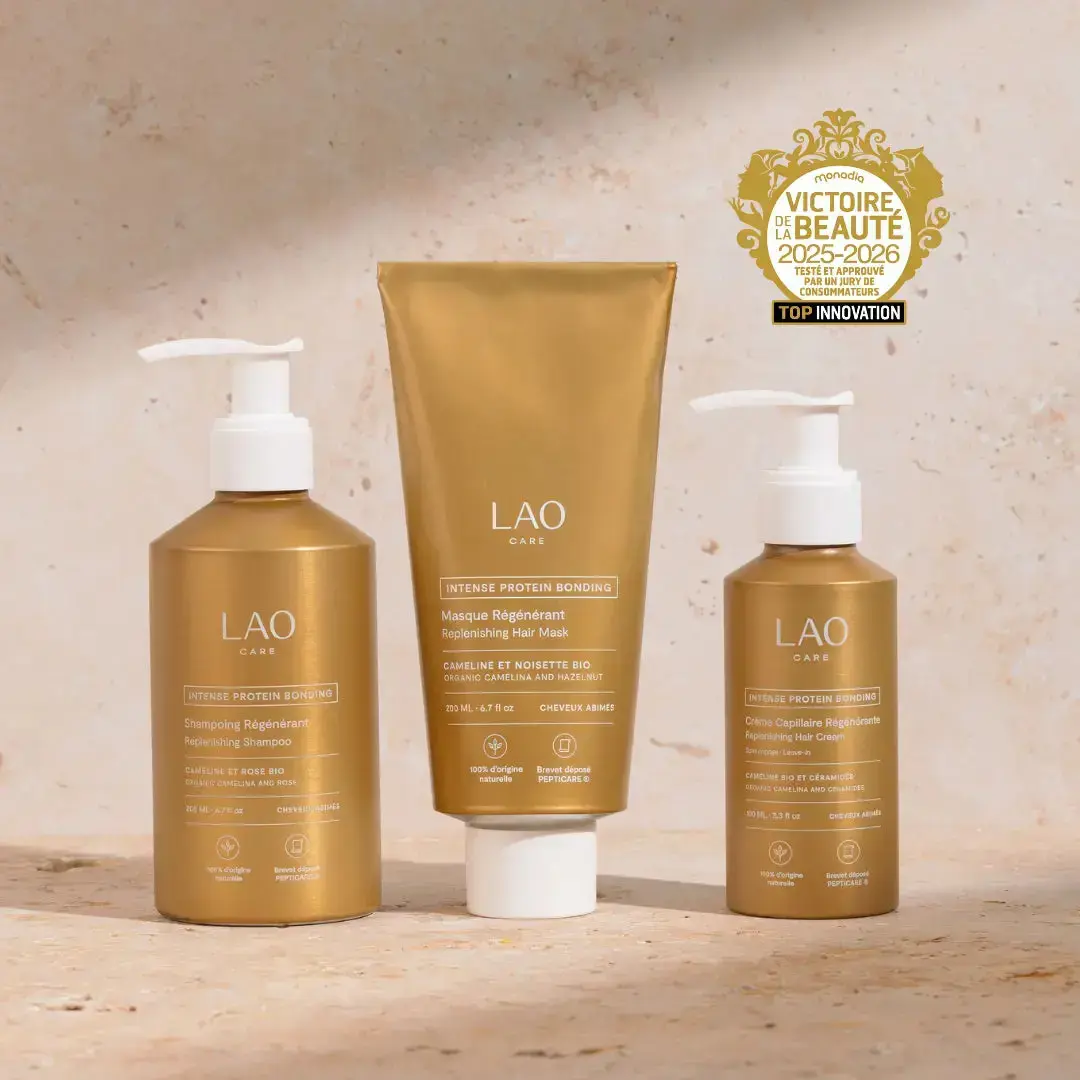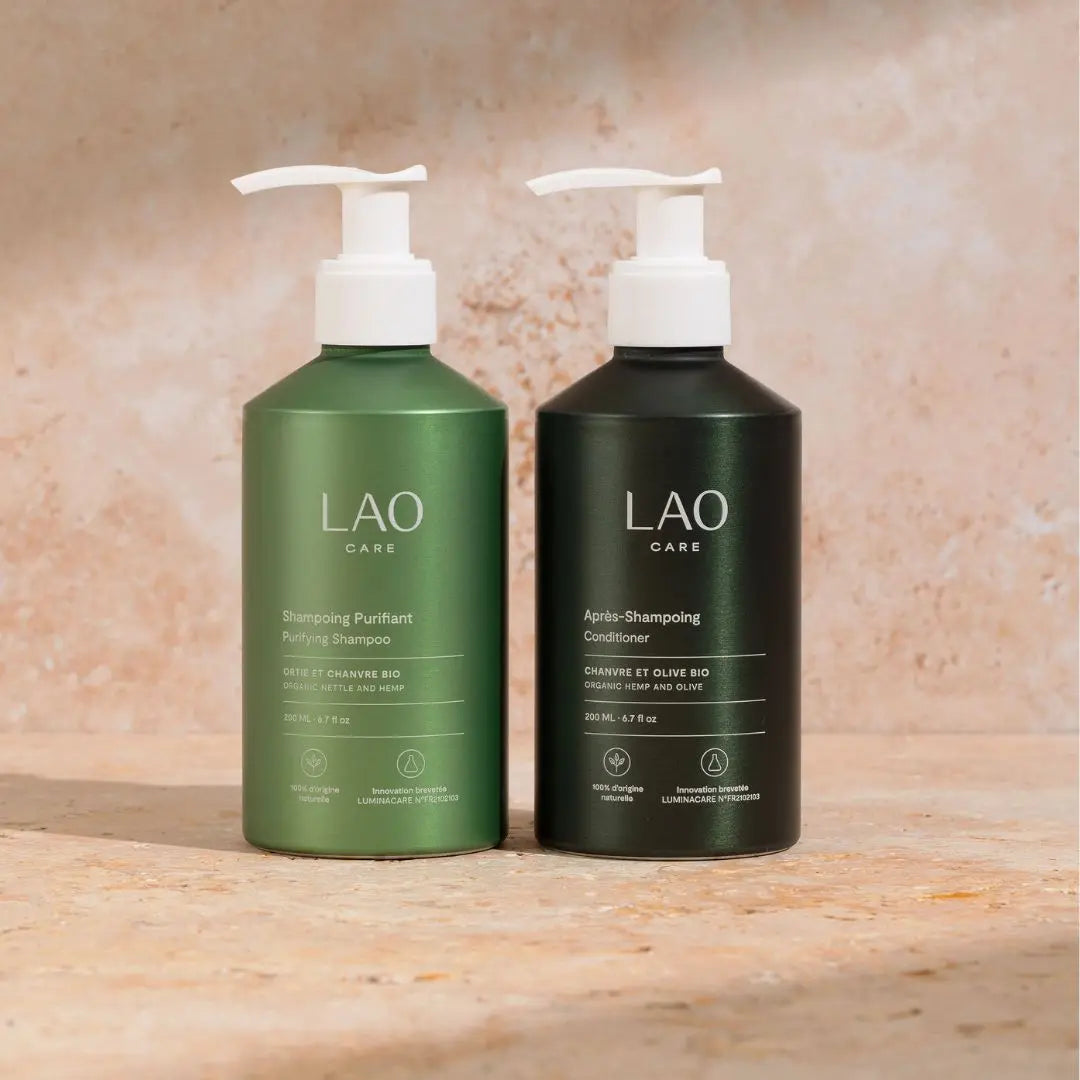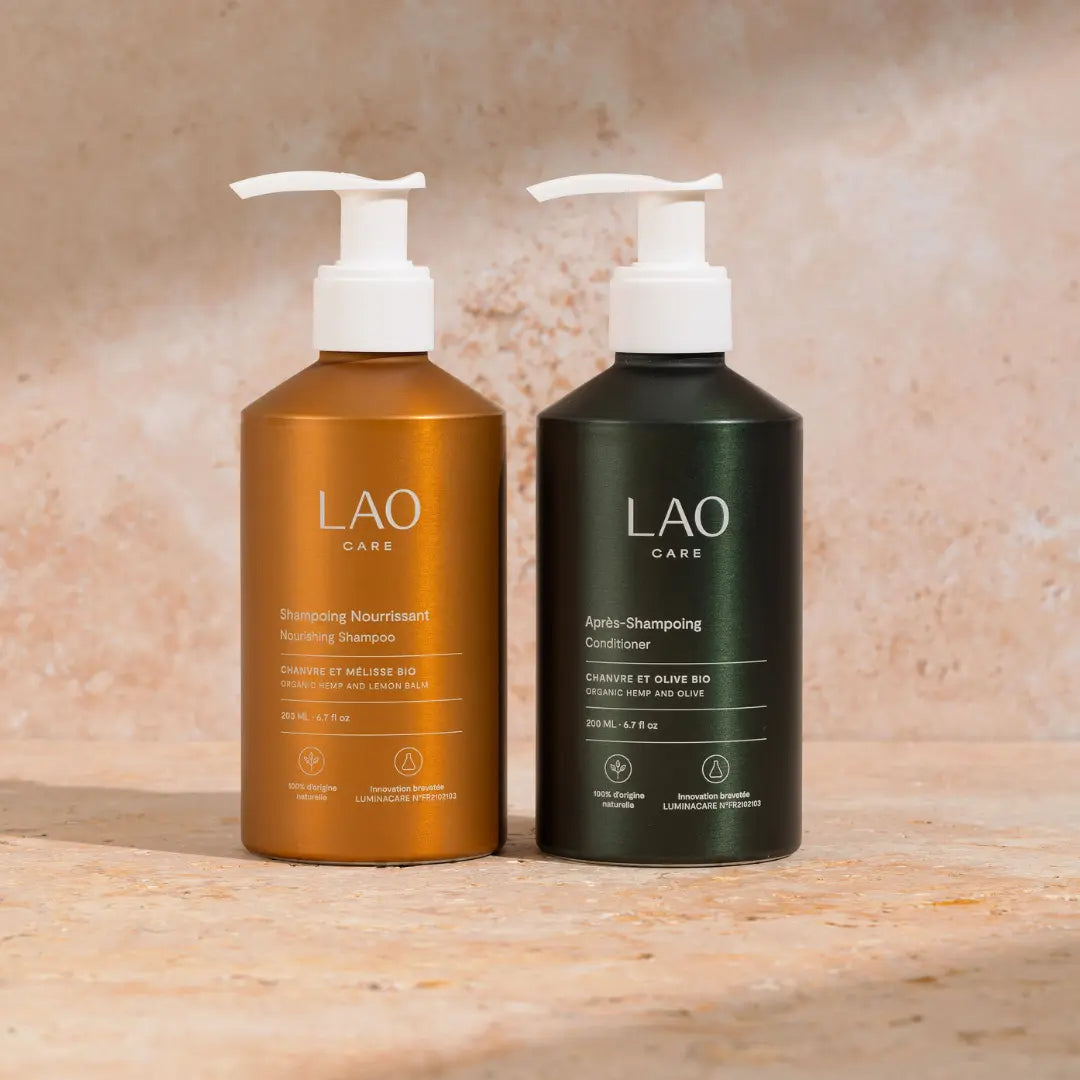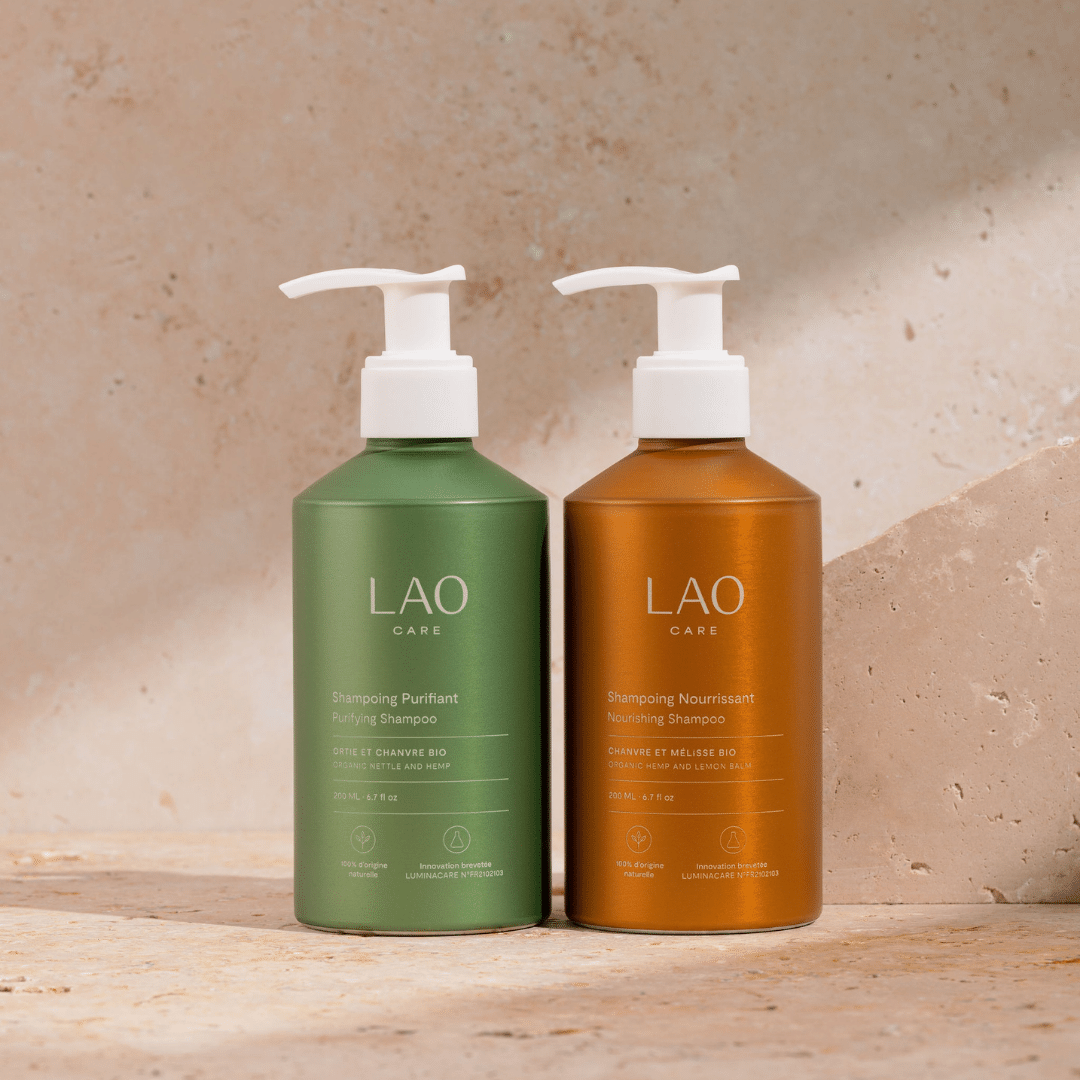When we first announced over a year and a half ago that we wanted to launch a natural liquid shampoo , a few of you immediately asked us why not a solid one.
It's true that solids are "trendy"; brands and the press are promoting them as THE zero-waste savior for your bathroom. Everyone is getting in on the act, from independent brands to mass retailers. What do all the sales pitches have in common? They're presenting you with an "eco-friendly" product, tapping into consumers' environmental awareness.
You should know that when I started LAO, I wanted to create a solid shampoo . It seemed obvious to me. Then I did two things:
- Spoke with a lot (really) of consumers
- Deepened research on the components of solid shampoo
Today's article aims to reveal what brands aren't telling you about solid shampoo . This will help you better understand why we opted for a liquid shampoo range first, and give you more information to help you choose your future purchases.
Types of solid shampoos
There are two types of products sold as solid shampoos at the moment:
- Soaps
- Solid shampoo bars
The soap
Let's start with soap, because we believe it is a consumer deception.
Yes, there are brands that sell you soaps called “solid shampoos”!
They are distinguished by their labels (often organic because they do not contain surfactants) and their composition, where the word “sodium” is frequently found (sodium palmate, sodium olivate, sodium sheabutterate, sodium castorate, etc.).
Why isn't soap suitable? It's very simple: its pH is far too basic compared to that of hair !
The pH of soap is around 9, while that of the hair shaft is acidic (around 3.67) and that of the scalp 5.5. By nature, soap will open the hair scales, which will expose the keratin and damage the hair in the long term.
On the other hand, increasing the pH of the hair makes it swell, porous, and fragile: the cuticle scales straighten and the hair becomes tangled, dull, and coarse, and will break more easily. This is especially true for long hair .
Short hair will not necessarily have problems because it is cut regularly and closer to the scalp, so the sebum secreted by it can compensate for the loss of acidity in the shaft after washing with soap.
Furthermore, according to a scientific study (in the sources at the bottom of the article), it is explained that soap is an anionic detergent that, upon contact with water, leaves an alkaline residue that is very bad for the hair in the form of calcium salt, which accumulates in the hair, leaving it opaque and tangled.
While using soap on the skin is not problematic because the skin quickly rebuilds its hydrolipidic film, this is not the case for your hair shaft!
Solid shampoo bar
A solid shampoo can be recognized by its surfactant composition (= washing agents). There are several types of surfactants used in solid shampoos, but they all belong to the same family: Sodium Cocoyl Isethionate (SCI), Sodium Lauroyl Methyl Isethionate (SLMI) are the main ones, but we also find Sodium Coco Sulfate for example. They are of plant + synthetic origin.
This is the SCI most commonly found in solid shampoos . It is these surfactants that pose serious problems.
We investigated to unmask them both in terms of their manufacture and their effect on the hair and scalp .
SCI and Derivatives Issues
Environmental
So, yes, we sell you solid shampoos based on SCI (40% to 70% in the formulas) as more ecological solutions, but who thought to inform you about the reality of its manufacture?
SCI is the result of the synthesis of sodium isethionate and the esterification of fatty acids, which requires products that are toxic to the environment. We find:
- Ethylene oxide (toxic, carcinogenic, mutagenic)
- Ammonia
- Sulfur dioxide
- Ammonium bisulfate
- Hydrochloric acid
- …
Several different processes are used for the synthesis of SCI, but one thing is common, they are all very polluting.
On the other hand, we do not find SCI in Europe to our knowledge; it will often come either from China or the United States and increases the carbon footprint of the ingredients.
Concentration
As mentioned above, solid shampoos are made up of around 30% to 70% surfactants, which is two to three times higher than liquid shampoos ! And this is used as a marketing argument to make you believe that the product will last longer, and that you are "not paying for water".
While the water in liquid shampoos has the primary function of being able to dilute the surfactants, which brings us to the skin and hair problem below.
Biodegradability
It should be noted that there is currently no standard that certifies the biodegradability of a finished product (OECD standards are used instead). Only the ingredients can be assessed, and SCI is not biodegradable and ends up with all these surfactants in the environment.
On the other hand, it is "harmful to aquatic life" and "causes long-lasting effects." If you still don't believe us, here is the label on the jar of SCI we bought from Aromazone, which includes the mandatory safety labeling information:

So yes, SCI is booming, but at what environmental cost?
Label
It is also because of all these elements (related to the environment and health) that the certification labels for natural cosmetics do not approve SCI. You will understand better why you do not see solid shampoo (which is not a soap, remember) certified organic!
Health: A word about powder shampoos
In recent months, we have seen the emergence of powder shampoos using SCI as a surfactant, which seriously concerns us for consumer safety.
Indeed, SCI is also volatile and dangerous for the respiratory tract; it would not occur to us to suggest to consumers to use shampoo powder containing SCI, and even less in the shower!
We will once again quote the safety instructions for use, recalled on the Aromazone website: "Powdery product, irritating to the respiratory tract, eyes and potentially skin when heated, must be handled with high gloves, safety glasses and a powder mask."
Negative effects on hair and scalp
Due to its high concentration of surfactants, which, as a reminder, remain detergents, solid shampoo can be irritating to the scalp and drying to the hair.
Indeed, it is not possible to dilute a solid shampoo 2 to 3 times to reach the level of a liquid shampoo. Even if SCI is often presented as a mild surfactant, given the phenomenon of dose-dependence and the concentration of the bar, beyond 40%, it will damage the hair in the long term (split ends, dryness of the hair fiber, etc.) and the scalp.
This also applies to liquid shampoos containing sulfates, surfactants known to be irritating.
Another significant effect is that a high concentration of surfactants will facilitate the transcutaneous passage (through the skin of the scalp) of other products and substances that are potentially problematic for health.
Solid shampoo: a big lie?
Yes and no. We don't want to blame it either, because it's still zero waste (relatively), but is a solid shampoo whose ingredients are very polluting during manufacturing and which will be very concentrated in surfactants for your hair and scalp really worth it?
Why we made a liquid shampoo
Quite simply because, to our knowledge and after having exchanged with numerous laboratories, there was no alternative to polluting surfactants at the time we created LAO to make a solid shampoo without SCI, SLMI, etc. and which corresponded to our particularly strict specifications which are based on:
Ingredients :
- Origin
- Manufacturing method
- Overall environmental impact
Formula:
- Generous foam
- Effectiveness on hair
This lack of alternatives is due to the fact that the solid shampoo trend is still very recent and raw material manufacturers have not yet developed surfactants suitable for a solid format that meet our requirements (environmental, health and quality).
This doesn't mean we'll never make solid shampoo!
On the contrary, we have already thought about it carefully, and when we release a solid shampoo, we will want it with the characteristics stated above, or not at all.
The benefits of liquid shampoo
Once we studied the solid shampoo and determined that it did not meet our product creation standards, we went to interview YOU to better understand what you expected and how we could help you have healthier hair naturally.
Out of nearly 400 respondents (general public panel), only 8% of you used a solid shampoo regularly, and nearly 18% had returned! This proved to us on the one hand that there is still work to be done on the sensoriality and effectiveness of solid shampoos , and showed us that nearly 92% of you use liquid shampoos !
Among them, nearly 78% told us that they were looking for a more ecological and natural shampoo!
We have therefore set ourselves the mission of responding to all those people who were looking for a more natural liquid alternative , even if it means going against the trend!
“Yes, but your liquid shampoos have a bottle!”
For us, zero waste is a great trend, but it's not enough. 1. The products created by brands must be desirable to everyone, not just a minority. 2. Brands must follow through on the approach throughout the entire value chain.
Just because a product is zero waste doesn't mean it's eco-responsible!
For us, the company's sustainable approach to product creation is evident at all stages of the value chain.
- Choice of ingredients (origin, manufacturing, distance from the factory, cultivation method, organic or not, etc.)
- % of ingredients in the formula (no ingredients there for communication, and a fair dose of active ingredients)
- Laboratory
- Factory
- Logistics
- …and of course the bottle.
For the bottle, we chose an aluminum one, which consumers can return to hairdressers and organic stores. These bottles will be cleaned and we will reuse them. The bottle will be the subject of a future article on our blog, where we will explain everything, including our points for improvement.
- Conclusion
There is no perfect solution at the moment, although clearly not all products are equal.
What matters to us is working across the entire value chain, not just proclaiming ourselves "sustainable" or "ecological" because we don't produce bottles. That's not enough, either for health or for the environment.
It is up to each consumer to choose consciously and to find out information before buying, and that was the aim of this article: to inform so that everyone can make their own choices.
It's also clear that the brand has a responsibility to communicate transparently, which is what we strive to do through our articles and our communication. We're not perfect either, even if we do everything we can, but at least we explain why!
Sources
-
Bushra T.AlQuadeiba, Eram KDEltahira, Rana A.BanafabLama A.Al-Hadhairib. Pharmaceutical evaluation of different shampoo brands in local Saudi market . January 2018. Saudi Pharmaceutical Journal. Volume 26, issue 1. Pages 98-106. Available online: https://www.sciencedirect.com/science/article/pii/S131901641730172X
This study, conducted in Brazil in 2014 on more than 123 shampoos, also draws on existing literature on the subject. It's fascinating!
-
Maria Fernanda Reis Gavazzoni Dias,Andréia Munck de Almeida,Patricia Makino Rezende Cecato,Andre Ricardo Adriano,and Janine Pichler. The Shampoo pH can Affect the Hair: Myth or Reality? International Journal of Trichology . 2014 Jul-Sep; 6(3): 95–99. Available online: https://www.ncbi.nlm.nih.gov/pmc/articles/PMC4158629/
-
CE Orfanos W. Montagna G. Stüttgen . Hair Research: Status and Future Aspects . December 2012.
-
Goodfellas. Why we didn't make solid shampoo . Available online: https://www.les-affranchis.bio/pourquoi-nous-ne-faisons-pas-de-shampoing-solide/
-
Aromazone. SCI Surfactant. Available online: https://www.aroma-zone.com/info/fiche-technique/tensioactif-sci-aroma-zone






1 comment
Article très instructif et complet merci pour ce partage de connaissance!!
En terme de transparence est qualité vous êtes dans le haut du panier. Et bravo pour le choix de bouteille aluminium lavable et réutilisable.
Leave a comment